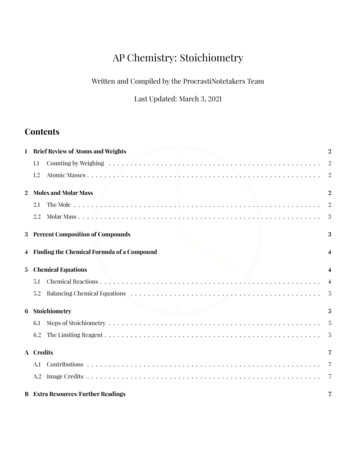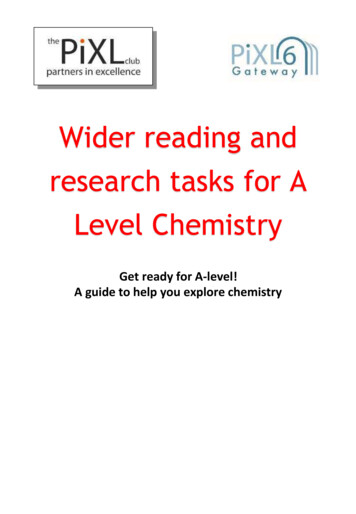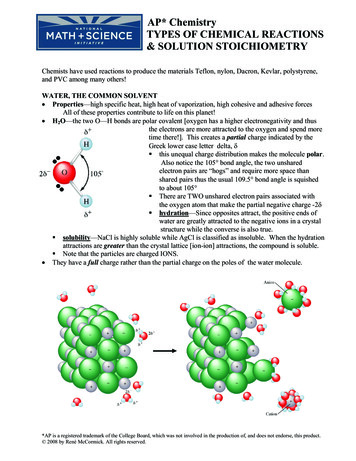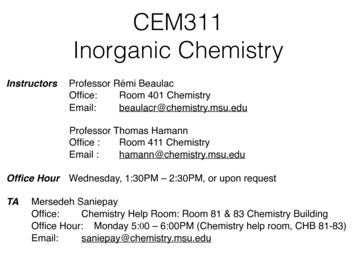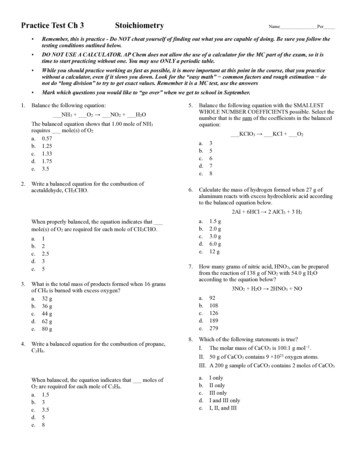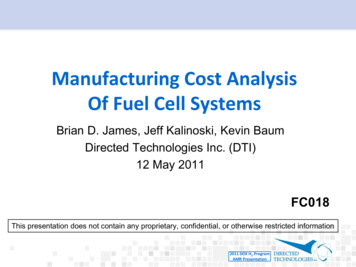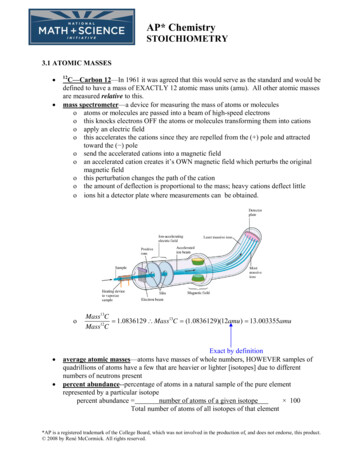
Transcription
AP* ChemistrySTOICHIOMETRY3.1 ATOMIC MASSES 12C—Carbon 12—In 1961 it was agreed that this would serve as the standard and would bedefined to have a mass of EXACTLY 12 atomic mass units (amu). All other atomic massesare measured relative to this.mass spectrometer—a device for measuring the mass of atoms or moleculeso atoms or molecules are passed into a beam of high-speed electronso this knocks electrons OFF the atoms or molecules transforming them into cationso apply an electric fieldo this accelerates the cations since they are repelled from the ( ) pole and attractedtoward the ( ) poleo send the accelerated cations into a magnetic fieldo an accelerated cation creates it’s OWN magnetic field which perturbs the originalmagnetic fieldo this perturbation changes the path of the cationo the amount of deflection is proportional to the mass; heavy cations deflect littleo ions hit a detector plate where measurements can be obtained.o Mass13C 1.0836129 Mass13C (1.0836129)(12amu ) 13.003355amu12Mass CExact by definitionaverage atomic masses—atoms have masses of whole numbers, HOWEVER samples ofquadrillions of atoms have a few that are heavier or lighter [isotopes] due to differentnumbers of neutrons presentpercent abundance--percentage of atoms in a natural sample of the pure elementrepresented by a particular isotopepercent abundance number of atoms of a given isotope 100Total number of atoms of all isotopes of that element*AP is a registered trademark of the College Board, which was not involved in the production of, and does not endorse, this product. 2008 by René McCormick. All rights reserved.
counting by mass—when particles are small this is a matter of convenience. Just as youbuy 5 lbs of sugar rather than a number of sugar crystals, or a pound of peanuts rather thancounting the individual peanuts .this concept works very well if your know an averagemass.mass spectrometer to determine isotopic composition—load in a pure sample of naturalneon or other substance. The areas of the “peaks” or heights of the bars indicate the relative2022abundances of 10Ne , 1021 Ne , and 10NeExercise 3.1The Average Mass of an ElementWhen a sample of natural copper is vaporized and injected into a mass spectrometer, theresults shown in the figure are obtained. Use these data to compute the average mass of naturalcopper. (The mass values for 63Cu and 65Cu are 62.93 amu and 64.93 amu, respectively.)3.2 THE MOLE mole—the number of C atoms in exactly 12.0 grams of 12C; also a number, 6.02 1023 justas the word “dozen” means 12 and “couple” means 2.Avogadro’s number—6.02 1023, the number of particles in a mole of anythingDIMENSIONAL ANALYSIS DISCLAIMER: Beginning on page 84 of the Chapter 3 text filesyou can find on this CD, you can find all of the remaining exercises worked out with dimensionalanalysis. This is most likely the way you were taught in Chemistry I. I will show you somealternatives to dimensional analysis. WHY? First, some of these techniques are faster and wellStoichiometry2
suited to the multi-step problems you will face on the AP Exam. Secondly, these techniques betterprepare you to work the complex equilibrium problems you will face later in this course. The firstproblem you must solve in the free response section of the AP Exam will be an equilibriumproblem and you will need to be able to work them quickly. Lastly, I used to teach both methods.Generations of successful students have encouraged me to share these techniques with as manystudents as possible. They did, once they got to college, and made lots of new friends once wordgot out they had this “cool way” to solve stoichiometry problems—not to mention their goodgrades! Give this a try. It doesn’t matter which method you use, I encourage you to use the methodthat works best for you and lets you solve problems accurately and quickly!ALTERNATE TECHNIQUE #1—USING THE MOLE MAP:Simply reproduce this map on your scratch paper until you no longer need to since the image willbe burned into your brain!MULTIPLY [by the conversion factor on the arrow] when traveling IN THEDIRECTION OF THE ARROW and obviously, divide when “traveling” againstan arrow.IF you start with moles, starthere, notice you multiply to “getaway” to any other quantityFROM moles.Stoichiometry3
When you draw this it will look more like this:Liters of gas@ STP# particles6.02 102322.4 L# of MolesMolar Mass (MM)Mass ingramsExercise 3.2Determining the Mass of a Sample of AtomsAmericium is an element that does not occur naturally. It can be made in very small amounts in adevice known as a particle accelerator. Compute the mass in grams of a sample of americiumcontaining six atoms. [There’s a periodic table on your CD—print it!]Exercise 3.4Determining Moles of AtomsAluminum (A1) is a metal with a high strength-to-mass ratio and a high resistance to corrosion;thus it is often used for structural purposes. Compute both the number of moles of atoms and thenumber of atoms in a 10.0-g sample of aluminum.Stoichiometry4
Exercise 3.5Calculating the Number of Moles and MassCobalt (Co) is a metal that is added to steel to improve its resistance to corrosion. Calculate boththe number of moles in a sample of cobalt containing 5.00 1020 atoms and the mass of the sample.3.3 MOLAR MASS, MOLECULAR WEIGHT, AND FORMULA WEIGHT molar mass, MM--the mass in grams of Avogadro s number of molecules; i.e. the mass of amole!molecular weight, MW--sum of all the atomic weights of all the atoms in the formula (it isessential you have a correct formula as you’ll painfully discover!)empirical formula--that ratio in the network for an ionic substance.formula weight--same as molecular weight, just a language problem ) “molecular”implies covalent bonding while Aformula@implies ionic bonding {just consider this to be agiant conspiracy designed to keep the uneducated from ever understanding chemistry—kindof like the scoring scheme in tennis}. This book uses MM for all formula masses.A WORD ABOUT SIG. FIG.’s—It is correct to “pull” from the periodic table as manysig. figs for your MM’s as are in your problem—just stick with 2 decimal places for all—much simpler!Exercise 3.6Calculating Molar Mass IJuglone, a dye known for centuries, is produced from the husks of black walnuts. It is also a naturalherbicide (weed killer) that kills off competitive plants around the black walnut tree but does notaffect grass and other noncompetitive plants [a concept called allelopathy]. The formula for jugloneis C10H6O3.a. Calculate the molar mass of juglone.b. A sample of 1.56 x 10-2 g of pure juglone was extracted from black walnut husks. How manymoles of juglone does this sample represent?Stoichiometry5
Exercise 3.7Calculating Molar Mass IICalcium carbonate (CaCO3), also called calcite, is the principal mineral found in limestone, marble,chalk, pearls, and the shells of marine animals such as clams.a. Calculate the molar mass of calcium carbonate.b. A certain sample of calcium carbonate contains 4.86 moles. What is the mass in grams of thissample? What is the mass of the CO32- ions present?Exercise 3.8Molar Mass and Numbers of MoleculesIsopentyl acetate (C7H14O2), the compound responsible for the scent of bananas, can be producedcommercially. Interestingly, bees release about 1µg (1 10-6 g) of this compound when they sting.The resulting scent attracts other bees to join the attack. How many molecules of isopentyl acetateare released in a typical bee sting?How many atoms of carbon are present?ELEMENTS THAT EXIST AS MOLECULESPure hydrogen, nitrogen, oxygen and the halogens [I call them the “gens” collectively—easier toremember!] exist as DIATOMIC molecules under normal conditions. MEMORIZE!!! Be sureyou compute their molar masses as diatomics. Others to be aware of, but not memorize: P4--tetratomic form of elemental phosphorous; an allotrope S8—sulfur’s elemental form; also an allotrope Carbon--diamond and graphite ) covalent networks of atomsStoichiometry6
3.4 PERCENT COMPOSITION OF COMPOUNDSTwo common ways of describing the composition of a compound: in terms of the number of itsconstituent atoms and in terms of the percentages (by mass) of its elements.Percent (by mass) Composition: law of constant composition states that any sample of a purecompound always consists of the same elements combined in the same proportions by mass.% comp mass of desired elementTotal mass of compound 100Consider ethanol, C2H5OHg 24.02 gmolgMass % of H 6 mol 1.01 6.06 gmolgMass % of O 1 mol 16.00 16.00gmolMass of 1 mol of C2H5OH 46.08 gMass % of C 2 mol 12.01NEXT THE MASS PERCENT CAN BE CALCULATED:Mass percent of C 24.02 g C 100% 52.14%46.08 gRepeat for the H and O present.Exercise 3.9Calculating Mass Percent ICarvone is a substance that occurs in two forms having different arrangements of the atoms but thesame molecular formula (C10H14O) and mass. One type of carvone gives caraway seeds theircharacteristic smell, and the other type is responsible for the smell of spearmint oil. Compute themass percent of each element in carvone.Stoichiometry7
Exercise 3.10Calculating Mass Percent IIPenicillin, the first of a now large number of antibiotics (antibacterial agents), was discoveredaccidentally by the Scottish bacteriologist Alexander Fleming in 1928, but he was never able toisolate it as a pure compound. This and similar antibiotics have saved millions of lives that mighthave been lost to infections. Penicillin F has the formula C14H20N2SO4. Compute the mass percentof each element.3.5 DETERMINING THE FORMULA OF A COMPOUNDWhen faced with a compound of “unknown” formula, one of the most common techniques is tocombust it with oxygen to produce CO2, H2O, and N2 which are then collected and weighed. empirical and molecular formulas: assume a 100 gram sample if given % soempirical gives smallest ratio need to know molar mass to establish molecular formula which is (empiricalformula)n, where n is an integer determining empirical and molecular formulas hydrates—“dot waters” used to cement crystal structures. anhydrous--without waterStoichiometry8
Example: A compound is composed of carbon, nitrogen and hydrogen. When 0.1156 g of thiscompound is reacted with oxygen [burned, combusted], 0.1638 g or carbon dioxide and 0.1676 g ofwater are collected. What is the empirical formula of the compound?Compound O2 Æ CO2 H2O N2but NOT balanced!!You can see that all of the carbon ended up in CO2 so when in doubt, FIND THE NUMBER OFMOLES!!0.1638 g 44.01 g/mol 0.003781 moles of CO2 0.003781 moles of CNext, you can see that all of the hydrogen ended up in H2O, so .FIND THE NUMBER OFMOLES!!0.1676 18.02 g/mol 0 .009301 moles of H2O, BUT there are 2 moles of H for each mole ofwater [ think “organ bank” one heart per body, one C per molecule of carbon dioxide—2 lungs perbody, 2 atoms H in water and so on ] so DOUBLE THE NUMBER OF MOLES TO GET THENUMBER OF MOLES OF HYDROGEN!! moles H 0.01860 moles of HThe rest must be nitrogen, BUT we only have mass data for the sample so convert your moles of Cand H to grams:g C 0.003781 moles C 12.01 0.04540 grams Cg H 0.01860 moles H 1.01 0.01879 grams H0.06419 grams total thus farSUBTRACT!0.1156 g sample – 0.06419 g thus far grams N left 0.05141 g N so .0.05141 g N 14.01 0.003670 moles NChemical formulas represent mole to mole ratios, so divide the number of moles of each by thesmallest # of moles of any one of them to get a guaranteed ONE in your ratios multiply by 2, then3, etc to get to a ratio of small whole numbers!!Element# molesCHN0.0037810.018600.003670StoichiometryALL Divided by0.0036701519
Therefore the correct EMPIRICAL formula is CH5N.Next, if we are told that the MM is 31.06 g/mol, then simply use this relationship:(Empirical mass) n MM(12.01 5.05 14.01) n 31.06Solve for nn 0.999678 or essentially one, so the empirical formula and the molecular formula are one inthe same.One last trick of the trade: When you don’t know the mass of your sample, assume 100 grams sothat any percents become grams .proceed by finding the number of moles!Exercise 3.11Determining Empirical and Molecular Formulas IDetermine the empirical and molecular formulas for a compound that gives the following analysis(in mass percents):71.65% C124.27% C4.07% HThe molar mass is known to be 98.96 g/mol.Stoichiometry10
Exercise 3.12Determining Empirical and Molecular Formulas IIA white powder is analyzed and found to contain 43.64% phosphorus and 56.36% oxygen by mass.The compound has a molar mass of 283.88 g/mol. What are the compound’s empirical andmolecular formulas?Exercise 3.13Determining a Molecular FormulaCaffeine, a stimulant found in coffee, tea, and chocolate, contains 49.48% carbon, 5.15% hydrogen,28.87% nitrogen, and 16.49% oxygen by mass and has a molar mass of194.2 g/mol. Determine the molecular formula of caffeine.Stoichiometry11
3.6 & 3.7 BALANCING CHEMICAL EQUATIONSCHEMICAL REACTIONSChemical reactions are the result of a chemical change where atoms are reorganized into one ormore new arrangements. Bonds are broken [requires energy] and new ones are formed [releasesenergy].CHEMICAL EQUATIONSchemical reaction--transforms elements and compounds into new substancesbalanced chemical equation--shows the relative amounts of reactants [left] and products [right] bymolecule or by mole. s, l, g, aq--solid, liquid, gas, aqueous solution NO ENERGY or TIME is alluded to Antoine Lavoisier (1743-1794)--law of conservationof matter: matter can neither be created nor destroyed) this means “balancing equations” is all his fault!!BALANCING CHEMICAL EQUATIONS Begin with the most complicated-looking thing (often the scariest, too). Save the elemental thing for last. If you get stuck, double the most complicated-looking thing. MEMORIZE THE FOLLOWING: metals halogens Æ MaXb CH and/or O O2 Æ CO2(g) H2O(g) H2CO3 [any time formed!] Æ CO2 H2O; in other words, never write carbonic acidas a product, it spontaneously decomposes [in an open container] to become carbondioxide and water. metal carbonates Æ metal OXIDES CO2Stoichiometry12
Exercise 3.14Balancing a Chemical Equation IChromium compounds exhibit a variety of bright colors. When solid ammonium dichromate,(NH4)2Cr2O7, a vivid orange compound, is ignited, a spectacular reaction occurs, as shown in thetwo photographs on page 105. Although the reaction is actually somewhat more complex, let’sassume here that the products are solid chromium(III) oxide, nitrogen gas (consisting of N2molecules), and water vapor. Balance the equation for this reaction.Exercise 3.15Balancing a Chemical Equation IIAt 1000ºC, ammonia gas, NH3(g), reacts with oxygen gas to form gaseous nitric oxide, NO(g), andwater vapor. This reaction is the first step in the commercial production of nitric acid by theOstwald process. Balance the equation for this reaction.3.8 STOICHIOMETRIC CALCULATIONS: AMOUNTS OF REACTANTS ANDPRODUCTSStoichiometry is the most important thing you can learn as you embark upon AP Chemistry!Get good at this and you will do well all year. This NEVER goes away!It’s time to repeat my dimensional analysis disclaimer.DIMENSIONAL ANALYSIS DISCLAIMER: Beginning on page 84 of the Chapter 3 text files you can find on thisCD, you can find all of the remaining exercises worked out with dimensional analysis. This is most likely the way youwere taught in Chemistry I. I will show you some alternatives to dimensional analysis. WHY? First, some of thesetechniques are faster and well-suited to the multi-step problems you will face on the AP Exam. Secondly, thesetechniques better prepare you to work the complex equilibrium problems you will face later in this course. The firstproblem you must solve in the free response section of the AP Exam will be an equilibrium problem and you will needto be able to work them quickly. Lastly, I used to teach both methods. Generations of successful students haveencouraged me to share these techniques with as many students as possible. They did, once they got to college, andmade lots of new friends once word got out they had this “cool way” to solve stoichiometry problems—not to mentiontheir good grades! Give this a try. It doesn’t matter which method you use, I encourage you to use the method thatworks best for you and lets you solve problems accurately and quickly!Stoichiometry13
First you have to be proficient at the following no matter which method you choose!: Writing CORRECT formulas—this requires knowledge of your polyatomic ions and beingable to use the periodic table to deduce what you have not had to memorize. Review section2.8 in your Chapter 2 notes or your text. Calculate CORRECT molar masses from a correctly written formula Balance a chemical equation Use the mole map to calculate the number of moles or anything else!Remember the mole map? It will come in mighty handy as well!# particlesLiters of gas@ STP6.02 102322.4 L# of MolesMolar Mass (FW)Mass ingramsHere’s the “template” for solving the problems you’ll create a chart. Here’s a typical example:What mass of oxygen will react with 96.1 grams of propane?[notice all words—you supply chemical formulas!]Molar Mass:BalancedEq’nmole:mole# molesamount(44.11)C3H8(32.00) 5 O215(44.01)(18.02)Æ 3 CO2 4 H2 O341. Write a chemical equation paying special attention to writing correct chemical formulas!2. Calculate the molar masses and put in parentheses above the formulas—soon you’ll figureout you don’t have to do this for every reactant and product, just those you’re interested in.3. Look at the coefficients on the balanced equation, they ARE the mole:mole ratios!Stoichiometry14
4. Next, re-read the problem and put in an amount—in this example it’s 96.1 g of propane.Molar Mass:BalancedEq’nmole:mole# molesamount(44.11)C3H8(32.00) 5 O2(44.01)(18.02)Æ 3 CO2 4 H2 O15342.1896.1 grams10.96.538.715. Find the number of moles of something, anything! Use the mole map. Start at 96.1 grams,divide [against the arrow] by molar mass to get the # moles of propane.6. USE the mole: mole to find moles of EVERYTHING! If 1 2.18 then oxygen is 5(2.18)etc . [IF the first you find is not a “1”, just divide to make it “1” and then it’s easy greasy!]Leave everything in your calculator—I only rounded to save space!7. Re-read the problem to determine which amount was asked for here’s the payoff .APproblems ask for several amounts! First, we’ll find the mass of oxygen required since that’swhat the problem asked. 31.95 moles 44.01 g/mol 349 g of oxygenMolar Mass:BalancedEq’nmole:mole# molesamount(44.11)C3H8(32.00) 5 O2(44.01)(18.02)Æ 3 CO2 4 H2 O15342.1896.1 grams10.9349 g6.53146 L8.71Now, humor me What if part b asked for liters of CO2 at STP [1 atm, 273K]? Use the mole map.Start in the middle with 6.53 moles [in direction of arrow] 22.4 L/mol 146 LAND how many water molecules are produced? Use the mole map , start in the middle with 8.71mol (6.02 1023) 5.24 1024 molecules of water.Try these two exercises with whichever method you like best!Stoichiometry15
Exercise 3.16Chemical Stoichiometry ISolid lithium hydroxide is used in space vehicles to remove exhaled carbon dioxide from the livingenvironment by forming solid lithium carbonate and liquid water. What mass of gaseous carbondioxide can be absorbed by 1.00 kg of lithium hydroxide?Exercise 3.17Chemical Stoichiometry IIBaking soda (NaHCO3) is often used as an antacid. It neutralizes excess hydrochloric acid secretedby the stomach:NaHCO3(s) HC1(aq) NaC1(aq) H2O(l) CO2(aq)Milk of magnesia, which is an aqueous suspension of magnesium hydroxide, is also used as anantacid:Mg(OH)2(s) 2HC1(aq) 2H2O(l) MgC12(aq)Which is the more effective antacid per gram, NaHCO3 or Mg(OH)2 ?Stoichiometry16
3.9 CALCULATIONS INVOLVING A LIMITING REACTANTEver notice how hot dogs are sold in packages of 10 while the buns come in packages of 8? Thebun is the limiting reactant and limits the hot dog production to 8 as well! The limiting reactant [orreagent] is the one consumed most entirely in the chemical reaction.Plan of attack: First, you’ll know you need a plan if you are given TWO amounts of matter thatreact.Next, when in doubt find the number of moles. Set up your table like before, only now you’llhave TWO amounts and thus TWO # ‘s of moles to get you started. I cover one up and “What if?”More to follow! It doesn’t matter where you start the “What if?” game .you get there either way.Let’s use a famous process [meaning one the AP exam likes to ask questions about!], the Haberprocess. This is basically making ammonia for fertilizer production from the nitrogen in the airreacted with hydrogen gas. The hydrogen gas is obtained from the reaction of methane with watervapor. This process has saved millions from starvation!! The reaction is below:Molar Mass:Balanced Eq’n(28.04)mole:mole1N2(2.02) 3 H2(17.04)Æ2 NH332# molesamountSuppose 25.0 kg of nitrogen reacts with 5.00 kg of hydrogen to form ammonia. What mass ofammonia can be produced? Which reactant is the limiting reactant? What is the mass of thereactant that is in excess?Insert the masses in the amount row and find the number of moles of BOTH!Molar Mass:BalancedEq’nmole:mole# molesamount(28.02)N2 (2.02)(17.04)Æ 2 NH33 H213892 moles25,000 g2,475 moles5,000 g2WHAT IF I used up all the moles of hydrogen? I’d need 1/3 2,475 moles 825 moles ofnitrogen. Clearly I have EXCESS moles of nitrogen!! Therefore, hydrogen limits me.ORWHAT IF I used up all the moles of nitrogen? I’d need 3 892 moles 2,676 moles of hydrogen.Clearly I don’t have enough hydrogen, so it limits me!! Therefore nitrogen is in excess.Either way, I’ve established that hydrogen is the limiting reactant so I modify the table:Stoichiometry17
That means I’ll use up all the hydrogen but not all the nitrogen!Molar Mass:(28.02)(2.02)(17.04)Balanced Eq’nN2 3 H2 Æ 2 NH3mole:mole1321650 mol# moles825 mol usedproduced892 moles2,475 moles1650 mol (17.04)amount825 mol (28.02) 28,116 g23,116 g usedproduced5,000 g25,000 g1,884 g excess!!Here’s the question again, let’s clean up any sig.fig issues:Suppose 25.0 kg of nitrogen reacts with 5.00 kg of hydrogen to form ammonia. (3 sig. fig. limit)What mass of ammonia can be produced? 23,100 g produced 23.1 kg (always polite to respond inthe unit given.Which reactant is the limiting reactant? hydrogen—once that’s established, chunk the nitrogenamounts and let hydrogen be your guide!What is the mass of the reactant that is in excess? 1,884 g 1.88 kg excess nitrogen!!Exercise 3.18Stoichiometry: Limiting ReactantNitrogen gas can be prepared by passing gaseous ammonia over solid copper(II) oxide at hightemperatures. The other products of the reaction are solid copper and water vapor. If a samplecontaining 18.1 g of NH3 is reacted with 90.4 g of CuO, which is the limiting reactant ? How manygrams of N2 will be formed?Stoichiometry18
Theoretical Yield: The amount of product formed when a limiting reactant is completelyconsumed. This assumes perfect conditions and gives a maximum amount!! Not likely!Actual yield: That which is realistic!Percent yield: The ratio of actual to theoretical yield.Actual Yield 100% Percent yieldTheoretical YieldExercise 3.19Calculating Percent YieldMethanol (CH3OH), also called methyl alcohol, is the simplest alcohol. It is used as a fuel in racecars and is a potential replacement for gasoline. Methanol can be manufactured by combination ofgaseous carbon monoxide and hydrogen. Suppose 68.5 kg CO(g) is reacted with 8.60 kg H2(g).Calculate the theoretical yield of methanol. If 3.57 104 g CH3OH is actually produced, what is thepercent yield of methanol ?Stoichiometry19
Stoichiometry 3 suited to the multi-step problems you will face on the AP Exam. Secondly, these techniques better prepare you to work the complex equilibrium problems you will face later in this course. The first problem you must solve in the free response section of the AP Exam will be an equilibrium

